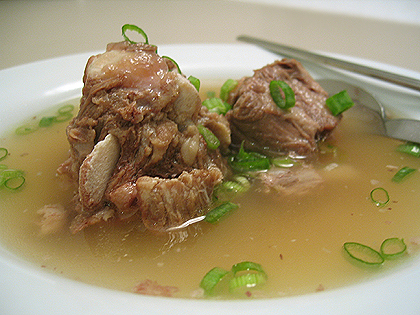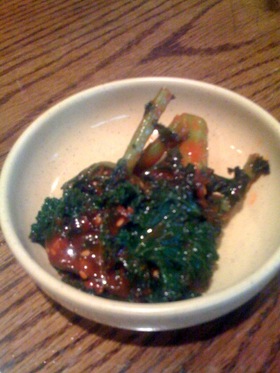December 17, 2008
Mi-Yuk Gook is not Hard

Growing up mi-yuk gook (Seaweed Soup) was often prepared at events or holidays so I came to associate it with making mandoo (dumplings) or rice cake, long arduous processes where I was often made to participate against my will. Hence my association with Mi-Yuk was also that it must be complicated not to mention those giant dried sheafs of seaweed that would sit mysteriously in our kitchen for well it seemed like years. What was more intimidating than that package of dried seaweed brought home from the Korean store that was as big as your torso?
Turns out, it is super easy to make. Too easy in fact and now I mourn all these years without having made it (though Korean moms might sympathize with the fact that I could not look at mi-yuk gook for months after the births of my two children!) (traditionally new Korean moms eat miyuk gook around the clock for three months and my own mom was pretty fanatic about this)
So here is a recipe for Super, Easy Mi-Yuk Gook:
1. Choose a pot for the amount of soup you want to make.
2. Fill with water 2/3. Add a generous amount of whole or minced cloves of garlic and half to a whole sliced onion.
3. If you want a beef based broth, add a pound'ish of a thick meaty shin bone or other great cut for making soup. Even easier is a a tablespoon of dried anchovy or me-loo-chi.
4. Boil then simmer for twenty minutes more or less.
5. Soak in warm water one or two paper sized portions of dried seaweed, or a small handful of the pre-cut kind for about ten minutes.
6. Add miyuk to your liking to the soup.
7. Soup is ready in about fifteen minutes. Salt and pepper to taste.
November 11, 2008
Maangchi
I want to talk like this woman...
Maangchi is a one woman website/blog/podcast/video all about Korean cooking. I've already watched three youtube's since I got the link a few minutes ago. Thanks Sonia!
August 3, 2008
kimchee stew for justin

There’s something so endearing about non-Koreans who get Korean food, especially when they love kimchee in all it’s forms. There have been a few people like that in my life, the first was a college roommate Joanna, a straight talking, wise cracking theater geek from Louisville, KY. She’d poke her head into whatever I was cooking or eating and take a huge bite without hesitation, declaring it usually, “Fantastic”. The girl could throw down kimchee and fermented stews like she’d been eating them her whole life rather than for the first time. I’d feel a surge of intense love for her each time she took a bite or slurped down a bowl of something particularly un-western and smelly and fishy, something akin to the religious bonding that happens over breaking bread.
The most recent weigook to move me thus is the husband of a friend whose enjoyment of the spiciest kimchee dishes is so passionate and moving, it prompts me to cook for him just so I can see him eat (or at least in my mind). He’s the kind of rare person who at the mention of say, super spicy kimchee stew or dok-bokki, a kind of deep light goes off in his eyes and he begins to salivate. A kind of greed takes over and it’s all he can do not to trample over his toddler and wife on his way to the kitchen. His wife recounted for me the first time I'd brought soup over, he’d slurped the whole thing down while standing up at the kitchen sink and declined to share even a bite. She said he wouldn’t even give her a taste. This from one a most patient and generous man. Outside of his kimchee jigage of course. So this simple recipe is for him and other weigooks who might feel intimidated by such a foreign dish, it really is one of the easiest recipes to make and anyone can do it:
1. Buy a 1/2 gallon jar or a bag of kimchee
2. Eat as much as you can stand and when it is more ripe than you can bear, throw it it in the fridge and forget about it for at least a week, two or more.
(I like to ripen my kimchee just short of disintegration- not a savory imagery I know but the more ripe your kimchee is, the deeper and better the flavor of your stew)
3. Saute at least 2-3 minced garlic cloves in a bit of sesame oil or whatever oil you have, about 5-8 for a 1/2 gallon jar of kimchee. (Again it’s hard to go wrong with too much garlic. You can add 1/2 or 1 sliced onion if desired.)
4. Add pork rib bits or pork stew meat, about a handful or more if you like meaty stews.
5. Put kimchee in the pot and sautee for a bit.
6. Add water until surface is a good few inches above the ingredients. Bring to a boil then put on simmer for an hour.
7. I like to rest the stew then simmer again for another hour but it isn't necessary.
Optional Additions: cubes of tofu, green onion, sesame seeds.
April 27, 2008
magic sauce
gochujang + sugar melted in a bit of hot water = instant banchan sauce!
Basically you can use this on almost any green vegetable and turn it into banchan: steamed broccoli, cauliflower, cabbage, brussel sprouts, spinach.. not to mention a veggie filled bibim- naengmyun!
Maybe everyone already knows this but it didn't hit me until I discovered this baby swiss chard banchan at a korean restaurant, it was simply blanched and then covered in this sauce. The slightly bitter leafiness of the chard balanced nicely with the spicy sweet sauce and I couldn't stop eating it:
(and many apologies for the headache inducing iphone photo - obviously I was too hungry while taking this one!)
March 20, 2008
white rice
mixes nicely with:

soft brown rice
pressed barley
wheat bulghur
thai royal purple sticky wild rices (small handful)
american wild rice (small handful)
throw a handful in your rice cooker and voila, whole grain meals!
February 21, 2008
Everyday Korean Cooking

Out of the twelve or so Korean cookbooks I've collected over the years my favorite so far has been Everyday Korean Cooking. When it was in print it was $12 but now the cheapest copy I could find was $50! In any case, I love that it is homemade looking, with a basic wire binder that they'll do for you at Kinko's and a font that reminds me of the early days when you had about two choices on your home computer.
I learned most of my basic dishes from this book and as I got used to making them I'd add ingredients and techniques from other cookbooks. (I find the nationalism and OCD aspects of Koreans come out when writing cookbooks because the recipes can get very long with almost arcane techniques and discussion such as one recipe which mourned the use of metal knives to cut vegetables when historically it was considered a kind of profanity, you ought to tear vegetables by hand.)
Here is a simple recipe for shigumchi, kongnamul, or soochoo namul:
1 bunch of spinach/ 1 bag of sprouts (pre-washed spinach will save you heartache)
3-4 diced scallions
2-3 minced garlic
1/2 teaspoon sugar
salt, pepper
soy sauce
sesame oil
sesame seeds (not essential but close)
1 teaspoon vinegar (again, not essential especially if you want to keep the banchan around for longer than two days, the vinegar quickly overripens the vegetables)
Directions:
1. Boil water in a medium sized pot.
2. When boiling, lower heat to high simmer, then blanch batches of vegetables for at least 20 seconds until wilted. (Blanching=dipping in hot water then removing) Vegetables should wilt but be slightly crunchy.
3. Drain and squeeze blanched vegetables. (Your armful of spinach will now fit in your hand)
4. Throw in garlic, scallion, and seeds (sesame seeds can be toasted) until it looks good to your eye. Taste.
5. Pour a bit of sesame oil in your hand and rub into vegetables. Taste.
6. Pour a bit of soy sauce in your hand and do the same.
7. Add sugar.
8. Add vinegar.
Mix and serve chilled if desired.
January 29, 2008
Super Easy Oxtail Soup (Gori or Kori Tang)
Now maybe it's because my mom saves every piece of plastic take-out container and food jar, or always cleans her plate (and yours) and still manages to be about 95 pounds of trim, South Korean churchlady but I love recipes that use every bit of it's ingredients. Like Kori Tang.
Now for those of you who have yet to get over the TAIL portion of oxtail please know it is BEEF, tastes just like beef but manages to be both lean and tender at the same time. It is a delicacy because it is a small portion compared to other cuts, and there's something about the ample bits of beef wrapped snugly around a big marrow-filled bone that give it an essence of beef flavor. In a subtle but pure way versus the in-your-face big flavor of steaks and grilling meats.
This soup is full of protein, calcium and iron in addition to all the vegetable goodness you can add in. (Turnip is traditional, it absorbs the beef broth perfectly while marrying it to a just a hint of turnip flavor. The kids hardly notice it and it will also mash well into rice for the most finicky of eaters!)

Ingredients:
Oxtail (found in the beef section of your grocery store)
Water
5-8 garlic cloves
1-2 onions
Med. Korean betchoo or 2-3 American turnips
Salt and Pepper to taste
Scallion for garnish
The Recipe:
For a full stock pot, use about seven or as many pieces of oxtail as will fit comfortable on the bottom. (For 2/3 of a stock pot of soup, use about five big pieces.)
Fill with water as discussed above.
Add 5-8 garlic cloves, 1-2 sliced onions.
Bring to boil, then simmer on the lowest simmer setting for at least an hour.
Remove oxtail and when cool, nudge off the meat and add back to the soup. (My mom always set aside some of the meat and would urge us kids into the kitchen to eat it while it was still hot. Sprinkled with salt and sometimes soy sauce, the meat would disappear in minutes!)
Add peeled and cubed betchoo (turnip).
Salt and pepper liberally to taste.
Return to simmer for about twenty minutes or however soft you like your turnip.
Eat as much as you want or remove as much as you want for eating before the next step.
...Add bones (probably without the small knob bits that fall off each oxtail piece) back to the soup and simmer again for about two or so hours until the bones release their marrow.

Soup will be milky white.
Garnish with scallion if you prefer.
(For a non-fat version, simply place soup after initial simmer in the refrigerator overnight and skim off hardened fat in the morning.)
January 9, 2008
Kalbi Tchim
One of the many reasons I wanted to start this blog was so I could make and keep in one collection, definitive recipes of Korean food. By this I mean one core recipe for each dish, with simple proportions to take the guesswork out of how to amend recipes for larger or smaller portions, and to describe the basic flavor combination so it'd be easy for people to make it sweeter if they'd prefer, or spicier, or saltier - you get the idea. Also, now that I have two kids, I find myself obsessed with one-pot dishes - anything with meat, vegetables and carbs altogether - and the simplest recipes possible without sacrificing taste or healthfulness. So, here goes: A recipe for kalbi chim that I made for a visiting cousin tonight.
The Quickest Tasty Kalbi Tchim
5 lbs short ribs
(the following vegetables are optional and are up to you, my only suggestion would be to do no more than three for the sake of seasoning it all)
(also, vegetables should be thickly cut so they don't fall apart in a lengthy simmer, I like a thumbs width at least)
one giant carrot or two normal sized ones
one med. potato, partially or totally peeled
6'ish large white mushrooms, shitake, crimini
one parsnip
one med. turnip
Marinade
4 stalks scallion
1 asian pear, peeled and grated/minced.
4 tbs rice wine
12 tbs soy sauce
3 tbs sugar
5 tbs minced or coarsely chopped garlic
black pepper to taste
Directions
1. Score rib meat diagonally to the bone, several times.
2. (optional) Heat a few tbs of oil in a pan and when very hot, sear each rib piece for a minute or two. This is purely for looks but adds a nice finishing touch to the meal.
3. Make marinade and evenly coat the ribs and vegetables.
4. Probably using two wide pots/sauce pans, spread the ribs and vegetables in one layer if possible, no more than two.
5. Bring to a boil then simmer if possible for at least an hour. It can be ready in thirty to forty minutes as well but I prefer a low, low simmer up to ninety minutes for a falling off the bone tenderness.
6. Most of the meal should eventually be simmering in it's juices, there's quite a bit. If not, I'd recommend spooning juices over portions that are not covered occasionally and/or bringing the ingredients at the bottom to the top, etc.
Flavor
This basic recipe is more soy sauce/salty than sweet. You can reduce by 1-3 tbs of soy sauce for a more balanced soy sauce to sweet flavor. You can add 1-2 tbs of red pepper for spiciness, and 1-2 tbs of sugar for a sweet saltiness.
Portions
This feeds five average sized adults with small second helpings.
January 8, 2008
Raw goodness
Well, first things first:
A Recipe for Eggbop
One bowl of steaming rice
One raw egg
Soy sauce to taste
Mix a few times until the rice is a broad swirl of white, yellow and black. Taste. Each creamy bite should be immediately followed by a rush of salty, soy goodness. Repeat. Add more soy sauce as needed.
I ate this meal happily throughout the seventies. Mom would serve it occasionally when things were busy, and it was sometimes presented at large gatherings for the kids. Nowadays my siblings and I are finding other Koreans our age don't know about this - was this particular to our family only? Was it a left-over Japanese thing?
I don't know why but I loved seeing the other kids' faces over their bowls - different heights, different sizes but all over the same bowl of steam and rice topped off by a giant yellow yolk.
